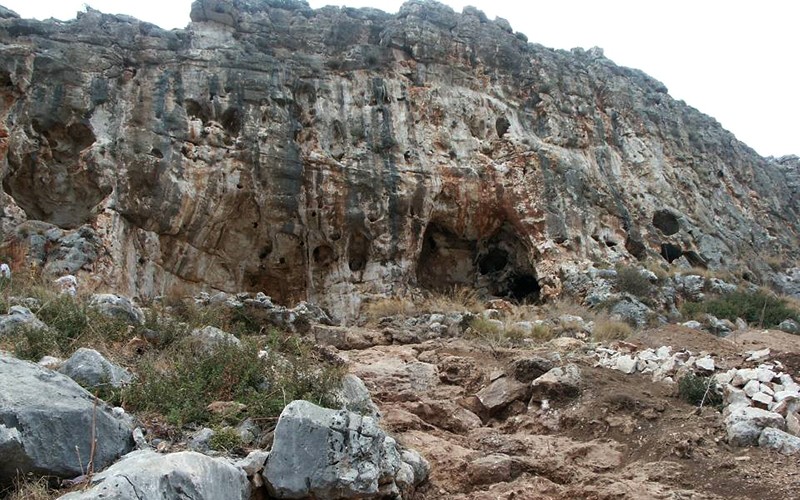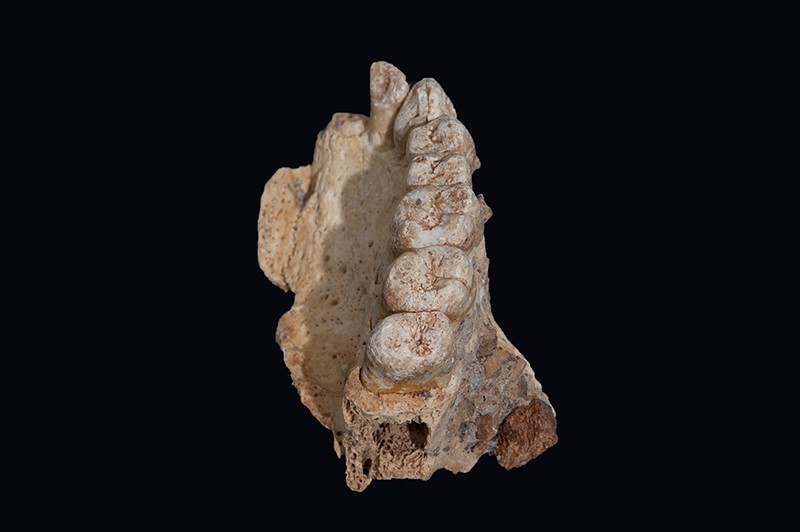THE HUMAN RACE IS OLDER THAN 6000 YEARS- THE SUPPOSED AGE OF THE EARTH BY SCIENCE DENIERS;
& RADICAL RELIGIOUS FUNDAMENTALIST EXTREMISTS
& "CRACKPOTS" SUCH AS iNDIANA CONGRESSMAN JIM BANKS
X
X
https://www.nature.com/articles/d41586-018-01261-5?utm_source=briefing-dy&utm_medium=email&utm_campaign=20180126
X
X
XX
X
NEWS
Israeli fossils are the oldest modern humans ever found outside of Africa
The oldest human fossils ever found outside Africa suggest thatHomo sapiens might have spread to the Arabian Peninsula around 180,000 years ago — much earlier than previously thought. The upper jaw and teeth, found in an Israeli cave and reported inScience on 25 January1, pre-date other human fossils from the same region by at least 50,000 years. But scientists say that it is unclear whether the fossils represent a brief incursion or a more-lasting expansion of the species.
Researchers originally thought that H. sapiens emerged in East Africa 200,000 years ago then moved out to populate the rest of the world. Until discoveries in the past decade countered that story, scientists thought that a small group left Africa some 60,000 years ago and that signs of earlier travels, including 80,000–120,000 year-old skulls and other remains from Israel discovered in the 1920s and 1930s, were from failed migrations.
However, recent discoveries have muddied that simple narrative. Some H. sapiens-like fossils from Morocco that are older than 300,000 years, reported last year2, have raised the possibility that humans evolved earlier and perhaps elsewhere in Africa. Teeth from southern China, described in 20153, hint at long-distance migrations some 120,000 years ago. And genome studies have sown more confusion, with some comparisons of global populations pointing to just one human migration from Africa4,5, and others suggesting multiple waves6.
Early start
In the early 2000s, archaeologist Mina Weinstein-Evron, at the University of Haifa in Israel, and palaeoanthropologist Israel Hershkowitz, at Tel Aviv University, began a project to excavate a series of Israeli caves. “We called it ‘Searching for the Origins of the Earliest Modern Humans’. This was what we were looking for,” says Weinstein-Evron.
Their team discovered the jaw fragment in 2002, in Misliya Cave, the highest of Mt Carmel’s caves. It is just a few kilometres away from the Skhul cave, one of the sites where the 80,000–120,000-year-old remains were found in the 1920s and 1930s. Using several different methods, the team estimates the jaw and teeth to be 177,000–194,000 years old.
X
The remains are unquestionably H. sapiens, says team member María Martinón-Torres, a palaeoanthropologist at the National Research Centre on Human Evolution in Burgos, Spain. The shapes of the teeth match those of both modern and ancient humans, she says. They also lack features typical of Neanderthals, which lived throughout Eurasia at the time.
The dating seems solid and the fossils are H. sapiens, says Huw Groucutt, an archaeologist at the University of Oxford, UK. But he isn’t very surprised to see them in Israel. He and his colleagues have previously said that 175,000-year-old stone tools from other sites in the Middle East resemble those used by H. sapiens in East Africa7.
Close encounters
Hershkowitz says that the jaw and teeth point to a long-term occupation of the Near East by early H. sapiens. “It was a central train station. People were coming and going through this land corridor from one continent to another, and it was occupied all the time.” Once there, humans probably encountered and interbred with Neanderthals, Hershkowitz says, pointing to a 2017 ancient-DNA study that suggested interbreeding had occurred before 200,000 years ago8.
Wet periods could have drawn humans into the Near East, but long, dry spells mean that “the region was probably more often a ‘boulevard of broken dreams’ than a stable haven for early humans”, Chris Stringer and Julia Galway-Witham, palaeoanthropologists at the Natural History Museum in London, write in an essay accompanying the paper9.
The fossil could indicate that Israel and the rest of the Arabian Peninsula were part of a larger region in which H. sapiens evolved, says John Shea, an archaeologist at Stony Brook University in New York. “We tend to think of Israel as part of Asia for geopolitical reasons, but it is really a transition zone between North Africa and western Asia,” he says. “Plenty of Afro–Arabian animals live there, or did so until recently,” including leopards, lions and zebras. “Homo sapiens,” Shea says, “is just another such Afro–Arabian species.”
XXXXXXXXXXXXXXXXXXXXX
References
- 1.Hershkovitz, I. et al. Sciencehttp://dx.doi.org/10.1126/aap8369 (2018).
- 2.Hublin, J.-J. et al. Nature 546, 289–292 (2017).
- 3.Liu, W. et al. Nature 526, 696–699 (2015).
- 4.Mallick, S. et al. Nature 538, 201–206 (2016).
- 5.Malaspinas, A.-S. et al. Nature 538, 207–214 (2016).
- 6.Pagani, L. et al. Nature 538, 238–242 (2016).
- 7.Groucutt H. et al. Quat. Int. 382, 8–30 (2015).
- 8.Posth, C. et al. Nature Commun. 8, 16046 (2017).
- 9.Stringer, C. & Galway-Witham, J. Science 359, 389–390 (2018).
X


No comments:
Post a Comment